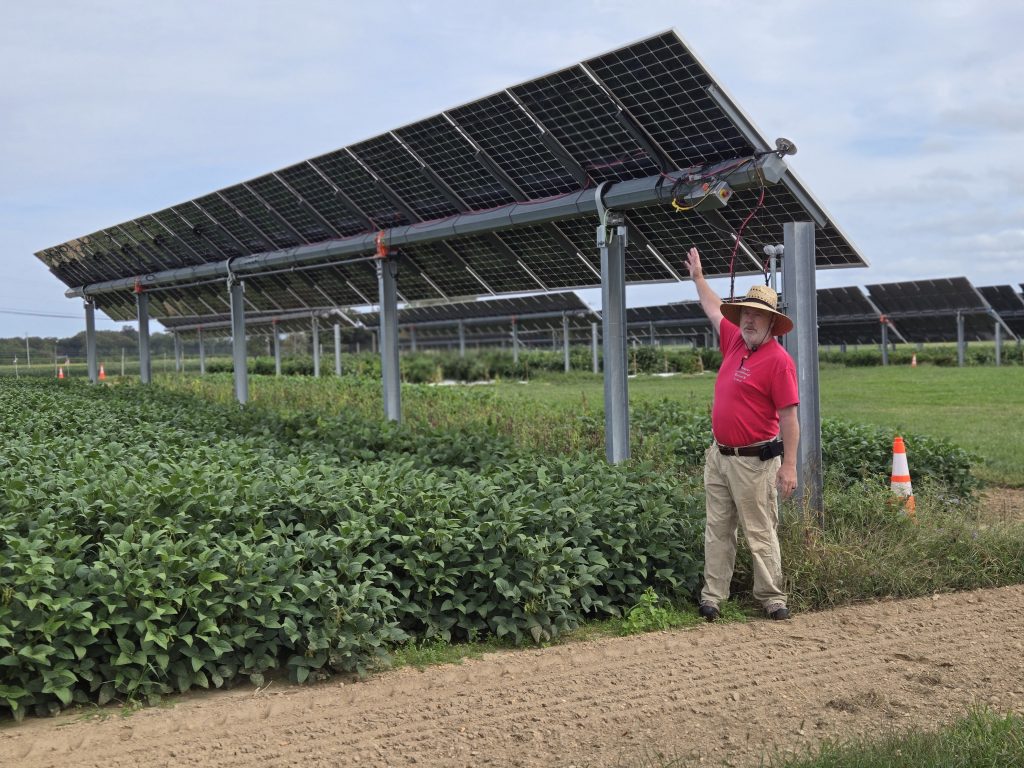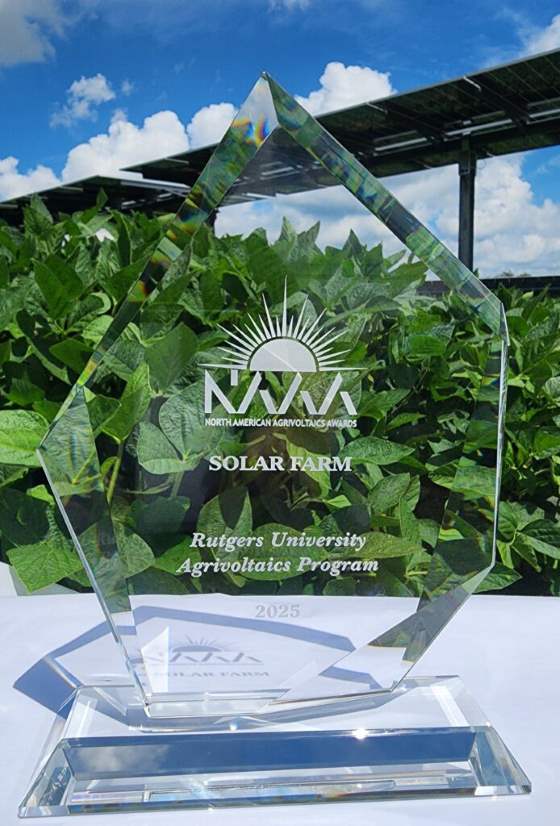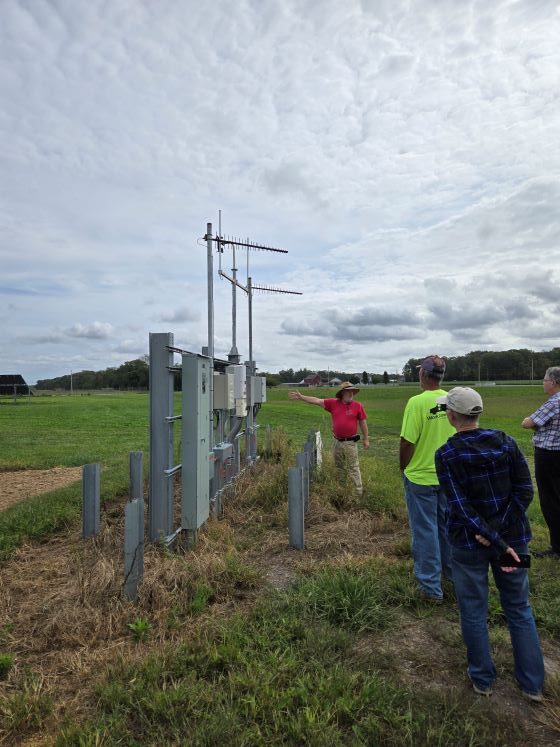
Soybeans thrive under solar panels on an experimental Rutgers farm in Bridgeton, NJ.
Turning Sunlight into Opportunity
The Garden State is turning sunlight into savings, crops, and a cleaner future for all.
By Heidi Yeh
Did you know that the first solar panel was invented in New Jersey? Sunday 9/21/25 was Sun Day, an international day of action and celebration of the power of solar energy. Events in New Jersey highlighted the history and future of solar panels in the Garden State.
One event was sited in Holmdel, where Bell Labs electrochemist Russel Ohl accidentally made a scientific breakthrough in 1940 that lead to the first practical modern solar cell (meaning, it was efficient enough to be worth the effort) in 1954. The technology and price has improved in leaps and bounds in the decades since, and it is now the cheapest form of energy available—and there are ways that EVERYONE in New Jersey can benefit from it.
Two other events highlighted the future of solar energy, at two Rutgers facilities where experiments are in progress to assess how to optimally integrate food and power production. We call this “dual-use” solar or agrivoltaics.
Crops with a Side of Kilowatts: Growing Food and Power Together
Agrivoltaics can help solve two problems here in the garden state: it uses land efficiently and can help make farms more financially sustainable.
- Efficient land use: Large solar farms often consume vast amounts of land, with the ground beneath them usually just mowed grass that provides little ecological value. In a densely populated state like New Jersey—already losing farmland to warehouses, data centers, and sprawling developments—solar expansion should avoid adding to this pressure on open space.

- Financial sustainability: New Jersey’s farmland preservation program has protected over 250,000 acres, but one-time state payments don’t always support future farmers bound by permanent deed restrictions. Agrivoltaics offer ongoing revenue, helping sustain farms financially while maintaining their essential role in food production.
Rutgers researchers have been studying the combination of solar panels with both livestock and vegetable/commodity crop production. They’ve been doing it so well, they were nationally recognized as the “Solar Farm of 2025” by The North American Agrivoltaics Awards (NAAA) program. You can learn more about their work from a recent presentation that they gave to the Pinelands Commission’s Policy & Implementation Committee.
This synergy between food and energy production is a fantastic idea—so why not just deploy en masse across the state? NJ will need to have about 17 GW of solar capacity installed (according to the 2019 Energy Master Plan) to meet its goal of 100% clean energy—perhaps more now that offshore wind has been delayed. As of 2024, NJ had installed about 5 GW, so we are only about 30% of the way there. I must confess that I underestimated how many questions still need to be answered about agrivoltaics so we can set up farmers for success!
Pairing food and energy production is a powerful idea—so why not start rolling it out everywhere in New Jersey TODAY? We are only about 30% of the way to reaching the 17 GW of solar capacity that NJ will need to install to reach its 100% clean energy goal, according to the 2019 Energy Master Plan. We need to install much more solar capacity, but this should be done in accordance with smart growth principles that encourage efficient land use. Pilot studies like the ones being conducted at Rutgers are laying the groundwork for the agrivoltaics… it will likely just take a few more years!
The Second Mouse Gets the Cheese
By going first, farms participating in this first round of pilot projects are addressing both the foreseen and unforeseen hurdles along the way. This will inform any permanent program that the NJBPU may establish and set up future farmers for success.
There are the more obvious questions, like which NJ crops will grow best in an agrivoltaic context? Do crops grown directly underneath or between solar panels perform differently? Preliminary results from Rutgers show that soybeans actually saw a small boost when grown under the panels. There were slight decreases for tomatoes, peppers, and eggplants, but the difference was not significant for the first two. Multiple replicates must be studied over multiple years to yield robust results. And there are hundreds of other crops that could potentially be studied!

There are also legal and economic questions: how do we find a balance that optimizes both power for the solar company and food production for the farmer? The panels are programmed to move throughout the day, following the angle of the sun to maximize power collection. However, sometimes the farmer needs the panels out of the way at a non-optimal angle so that farming equipment can be run underneath, but some solar energy production will be sacrificed in the process. Contract negotiations with the solar companies need to give farmers sufficient control over the function of the panels.
There are also factors that the farmers will never be able to control, like the electric grid. For example, although the Rutgers experiments are well underway, only about 1/3 of the power that their Bridgeton facility is producing is actually being fed into the local electric grid—sending out more would require about a million dollars to upgrade the nearest substation. The rest of the power is either used onsite or wasted. They are still operating the solar panels as if the energy was being used to assess its impact on crop production, but it is highly unfortunate to waste those potential energy gains. This highlights the critical bottleneck that our aging energy infrastructure represents for making progress on all of our energy problems. Battery storage is needed to improve the resiliency of our grid at every level and can store wind and solar energy like this that is otherwise ‘curtailed’—for example, California wasted 3.4 million MWh of this energy in 2024 that could have been stored in batteries and used later.
Power to the Pinelands?
Unfortunately, dual-use solar farms like these will not be popping up in the Pinelands anytime soon. The wording of the Pinelands Comprehensive Management Plan currently does not allow it. Pinelands Commission members and staff have been very supportive of the concept, but reluctant to go through the months-long process of amending the CMP while the BPU is still hashing out the details of its pilot programs.
In addition to the paperwork, there is a bit of a catch-22: we want to know how iconic Pinelands crops like cranberries and blueberries will fare in our specific context when combined with solar panels—but we can’t start experimenting and collecting that data on real Pinelands farms until agrivoltaics are allowed by the CMP.
So, where can solar energy be built in the Pinelands? To avoid wasteful land use—like large solar farms that cover huge areas with little ecological benefit—solar installations as the primary use of land are not permitted. Rooftop and parking lot solar? Absolutely—these projects don’t even require review by the Pinelands Commission. Ground-mounted solar is more restricted: large, utility-scale arrays that feed energy into the grid are not allowed. The only exception is for smaller arrays that directly serve on-site needs, such as a farm generating enough power for its own operations.
To build the kind of solar farms that can serve entire communities, Pinelands developers are limited to highly disturbed land, such as mining sites and landfills. This has had the somewhat unexpected benefit of incentivizing Pinelands towns to finally cap their landfills that had been abandoned for decades without proper decommissioning—so far over 24 MW of solar have been installed on these sites.
No roof? No problem!
New Jersey’s Community Solar Program is turning abandoned Pinelands landfills into solar farms, bringing affordable renewable energy to everyone— yes, that includes YOU! Especially if you are a renter or don’t own a solar-compatible rooftop. The benefits of cheap solar shouldn’t only be available to those who can afford the up-front cost, so New Jersey has you covered: Subscribers can save 20–40% on their energy bills. Learn more (starting with this 3-minute video) and sign up through the state’s website here.
Want to help spread the word? Here is a handout with important links for your neighbors: SolarHandout-PinelandsAlliance.pdf
